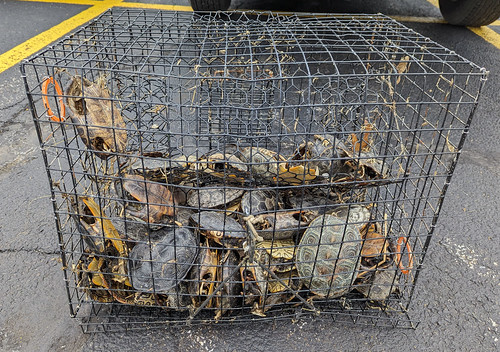
Crab traps with turtle excluders attached are available at many retailers. Maryland DNR photo.
Maryland’s blue crab season officially opens April 1 in Chesapeake Bay and its tidal tributaries and the Atlantic Ocean and coastal bays. With the opening of a new season comes an increased presence by Natural Resources Police (NRP) officers to educate the public and enforce laws pertaining to crabbing, particularly with recreational crabbers and owners of private shorelines.
“While Marylanders are looking forward to the opening of blue crab season, it’s important to stay in compliance with current laws and regulations,” Brian Rathgeb, Acting Deputy Superintendent of the NRP said. “Whether you are crabbing from your dock or elsewhere, remember that NRP officers will be actively enforcing all crabbing laws and regulations including crab pot turtle reduction devices, proper markings, and owner’s proper licensing and registrations.”
Many turtle reduction devices are bright orange plastic rectangular devices fitted in crab pot entrance funnels. They have been required by law on recreational crab pots in Maryland since 1999. Large diamondback terrapins won’t fit through the state-regulated devices (1.75 inches x 4.75 inches), but they do not interfere with catching legal crabs.

Terrapins killed in a crab pot not outfitted with turtle reduction devices. Photo by Beth Schlimm, Maryland Department of Natural Resources.
Diamondback terrapins, the state reptile, face tremendous danger in crab pots not fitted with reduction devices. Terrapins are lured into crab pots by the same baits used to attract blue crabs. However, unlike blue crabs, terrapins must rise periodically to the surface to breathe air. Terrapins trapped in a fully submerged crab pot will drown.
“Once prevalent in state waters, terrapins today face many challenges in the Chesapeake Bay and Atlantic coastal waters,” Jonathan McKnight, Associate Director of DNR’s Natural Heritage Program said. “Loss of habitat and crab pot mortality pose significant threats to their population. When crabbing this season, keep the turtles in mind and know that your efforts are crucial in the conservation of this species.”
Researchers from DNR’s Wildlife and Heritage Service alongside NRP officers performed routine recreational crab pot checks in 2016, finding turtle reduction devices compliance as low as 53 percent. Marylanders are reminded that in addition to mandated turtle reduction devices, recreational crab pots must also be registered annually and marked with the owner’s DNRid or name and address. NRP Officers are checking for gear compliance as frequently as ever, significantly increasing the number of crabbing related inspections from 2022 to 2023, while also recording a 13.6% increase in crabbing citations and warnings issued year-over-year.
Pots not affixed with turtle reduction devices can still be bought legally, however the devices must be installed prior to recreational use. As awareness of the devices has increased, many recreational crab pots now sold include the turtle-saving feature.
The plastic devices last longer than the galvanized wire versions, which might deteriorate over time due to rust, officials with DNR’s Wildlife & Heritage Service stated. In a pinch, crabbers can make their own turtle reduction devices, but should also acquaint themselves with the latest state rules and regulations related to crabbing.

Blue crab caught in pot. Maryland DNR photo.
“The harvest regulations in place are there for the future of crabbing in Maryland,” said Michael Luisi, Associate Director of DNR’s Fishing and Boating Services. “Crabbing is a time-honored tradition in our state and blue crabs are one of the most important species harvested in the Bay. For future generations to enjoy the blue crab harvests that we have, rules and restrictions on crab sizes, catch limits, and methods must be followed to maintain a healthy and sustainable blue crab population.”
Maryland’s blue crab season runs from April 1 to December 15 in the Chesapeake Bay and December 31 in the Atlantic Ocean and its coastal bays and tidal tributaries. The state’s blue crab harvest accounts for over 50% of total U.S. landings. While not mandated for every recreational crabber, Maryland DNR issued nearly 70,000 crabbing licenses and crab pot registrations in 2023.
